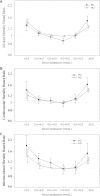Serum potassium and cause-specific mortality in a large peritoneal dialysis cohort
- PMID: 22626960
- PMCID: PMC3408121
- DOI: 10.2215/CJN.00960112
Serum potassium and cause-specific mortality in a large peritoneal dialysis cohort
Abstract
Background and objectives: Unlike hemodialysis (HD), peritoneal dialysis (PD) is a continuous therapy and does not induce myocardial stunning. Yet, the death risk in HD and PD patients is similar. This study tested the hypothesis that serum potassium abnormalities contribute more to the death risk in PD patients than in HD patients.
Design, setting, participants, & measurements: Data from patients treated in DaVita facilities between July 1, 2001 and June 30, 2006 (n=10,468 PD patients; n=111,651 HD patients) were used to determine association of serum potassium with mortality.
Results: PD patients were significantly more likely to have serum potassium < 4 mEq/L, with an adjusted odds ratio of 3.30 (95% confidence interval [95% CI], 3.05, 3.56). There was a U-shaped relationship between time-averaged serum potassium and all-cause and cardiovascular mortality of PD patients, with adjusted hazards ratios of 1.51 for all-cause mortality for potassium < 3.5 mEq/L (95% CI, 1.29, 1.76) and 1.52 for potassium ≥ 5.5 mEq/L (95% CI, 1.32, 1.75). The population-attributable risks for all-cause mortality for serum potassium < 4.0 and ≥ 5.5 mEq/L were 3.6% and 1.9%, respectively, in PD patients, and 0.8% and 1.5%, respectively, in HD patients.
Conclusions: Abnormalities in serum potassium contribute disproportionately to the high death risk in PD patients. This may, in part, account for the equivalent cardiac risk seen with the two therapies.
Figures




References
-
- National Institutes of Health, US Renal Data System : USRDS 2011 Annual Data Report: Atlas of Chronic Kidney Disease and End-Stage Renal Disease in the United States, Bethesda, MD, National Institutes of Health, 2011
-
- Gross ML, Ritz E: Hypertrophy and fibrosis in the cardiomyopathy of uremia—beyond coronary heart disease. Semin Dial 21: 308–318, 2008 - PubMed
-
- Kalantar-Zadeh K, Kopple JD, Regidor DL, Jing J, Shinaberger CS, Aronovitz J, McAllister CJ, Whellan D, Sharma K: A1C and survival in maintenance hemodialysis patients. Diabetes Care 30: 1049–1055, 2007 - PubMed

